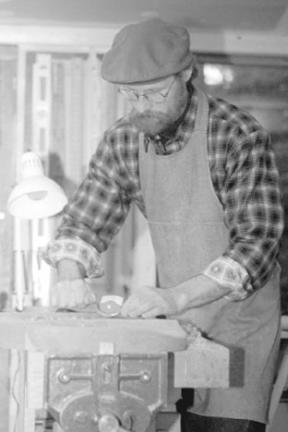While furniture, be it a table, chair or cabinet, is often just furniture, if it’s custom built it can serve both practical needs and as art.
Craftsmanship and unique designs, conjured up in small workshops by exacting woodworkers, take furniture beyond its utilitarian function. In recent years, a concentration of these craftsmen on Whidbey Island has made local wood shops and art galleries some of the better places to look for something artistic to sit on.
What island furniture makers such as David Gray, John Shinneman, Rob Hetler and Robert Hall Bennett offer is not for everybody or every pocketbook. Often priced like fine art, custom dining chairs can cost as much as $1,000 apiece and tables and cabinets can run as much as $7,000.
But when chosen as the focal point of a room, furniture made by these men and others on the island can be investments and even heirlooms. And, said Freeland furniture maker John Shinneman, the price is not always steep.
“There are ridiculously high mark-ups on some of the finer makes of retail furniture,” he said. “For a little more, people can buy one-of-kind handcrafted items.”
Shinneman says it’s common for him to work within a customer’s budget to create something that will be appreciated and valued when it is finished.
Like many other furniture builders on the island, Shinneman does his work on commission. Working like this, he may only do a few projects in a year, eschewing volume for quality and beauty. With most projects, clients are ordering something that isn’t available in traditional furniture showrooms.
“I am a problemsolver,” Shinneman said. “My clients may look at regular furniture outlets for a specific piece to fit a function and can’t find what they are looking for.”
The design work begins with meticulous scale drawings down to every detail so both woodworker and client are clear and confident of what the final product is going to be, right down to the color of the wood.
Shinneman will work with a client to create what they want, including designing and fabricating the hardware. His projects have run the gamut between two dramatic spiral staircases with 100 turned balusters and four handrails, to an intricately designed silverware chest.
It is not unusual for a custom woodworker to be called to a client’s home to design and build something, such as a wall cabinet, for a specific location.
This is easy to do when the business is local, like it is for Greenbank woodworker Rob Hetler. This clientele has been good to him in the past year, he said, and did not let the downturn in the economy affect their planned purchases.
In the middle of building a library for a client this fall, Hetler said Sept. 11 actually seemed to convince some people considering purchasing his work to commit to projects.
“I think the feeling was, we are going to move forward from this,” he said.
Woodworking is not just a business venture for island wood artisans like Hetler and Shinneman. It is also art and a calling.
Hetler is as intrigued with the process of shaping the cherry and maple he uses in his furniture as he is in the finished product. Discovering surprises inside the wood, like the patterns created by fungal growth, is its own reward.
“Incredible patterns are created by the fungus,” he said. “I like to emphasize those.”
The wood has also drawn South Whidbey furniture maker Robert Hall Bennett to the smaller details. He began his career as a boat builder, but after building a stateroom on a yacht he narrowed his focus to furniture. His work is now regularly on display at Museo Gallery in Langley, along with the paintings, blown glass and sculpture.
This is as it should be, by Bennett’s reasoning.
“Each piece is art to me because of the woods used and the design itself,” he said.
The variety of woods these craftsmen use is a contributing factor to the appearance and feel of the furniture they make. Bennett sometimes uses two or three different kinds in one piece of furniture, including paduka, a wood that darkens with age. It makes a good contrast with lighter woods.
Bennett and other local furniture makers are influenced by the craft style of the turn of the 19th century. The diamond-shaped, faceted ebony plugs Bennett uses in his furniture is just one of the hallmarks of the period.
“They are reminiscent of Shaker-style furniture,” he said.
David Gray, a Langley-area furniture builder, operates a small factory where he and four employees build about 100 chairs and 70-80 other pieces a year. He markets his products widely, selling in five Northwest stores, including Island Design in Langley, and shops in LaConner, Seattle and Portland.
Most of Gray’s work is in the Craftsman style. In recent years, he has focused on producing several lines of furniture in styles he enjoys. With a larger operation than other woodworkers on the island, Gray can market more widely, sell at attractive prices and keep up with demand.
“The quality and economy of this limited production format is appealing and accessible,” he said.
Though set up to build furniture from standard designs, Gray still does some custom work.
Is the price worth it? That, say these woodworkers, is for the buyer to decide.



